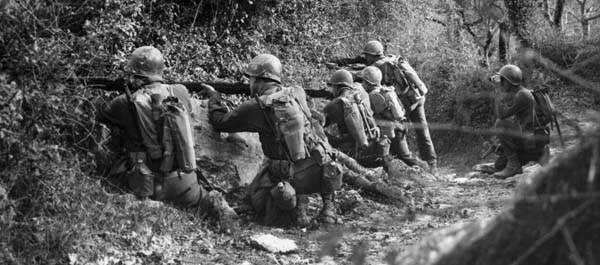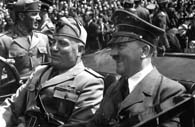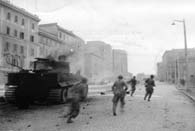A Little Known Tale of War

World War II was not just about the well-known campaigns and battles that most of us are familiar with. There were literally thousands of other smaller battles, incidents, even campaigns that have either not attracted the attention of historians or have simply gone unnoticed and undocumented.
Most Americans are only familiar with the western side of the war. Thanks to the superb work of historians like the late John Erickson and more recently by David M. Glantz, Antony Beevor, Reina Pennington and others, we have a much clearer picture of the Red Army and the great campaigns fought on the Eastern Front.
{default}Other protagonists like Italy have had very little written about their participation in the war. It’s almost as if history has by-passed Italy. Seminars are rarely held on the subject and books tend to be obscured by other more “glamorous” battles and campaigns.
The Italian campaign has been routinely short-changed for more than a half century despite the fact that it was the longest and bloodiest campaign fought by the western allies.
 The Italian side of the war is a prime example. Yet, World War II was the most oppressive period of Italian history. From 1922 until his arrest and overthrow in July 1943 Italy had been under the authoritarian rule of Benito Mussolini and his Fascist thugs. The Italian nation was a study in torment brought about by Mussolini’s unsavory and ultimately disastrous alliance with Adolf Hitler’s Nazi Germany.
The Italian side of the war is a prime example. Yet, World War II was the most oppressive period of Italian history. From 1922 until his arrest and overthrow in July 1943 Italy had been under the authoritarian rule of Benito Mussolini and his Fascist thugs. The Italian nation was a study in torment brought about by Mussolini’s unsavory and ultimately disastrous alliance with Adolf Hitler’s Nazi Germany.
Beginning with the 1936 invasion of Ethiopia, Mussolini had attempted to ape the glory days of the great Roman empires which had dazzled the world with feats of military victory and cultural achievement. Instead, what Il Duce brought to Italy was not glory but anguish through an old form of dictatorship wrapped in new cloth. The empty sham of Italian Fascism was glaringly evident to the Italian people, most of whom longed for an end to the war.
When Mussolini was ousted there were wild celebrations in Rome, which were short lived. Although Italy’s new non-Fascist government, headed by Field Marshal Pietro Bagdolio, proclaimed the war would go on as before, within weeks he began secretly negotiating an armistice with the Allies.
The Allied armies had already begun the liberation of Italy when the British Eighth Army invaded Calabria, the boot of Italy, on September 3. On September 8, 1943 an armistice was concluded with the Allies. Although Italy’s capitulation meant that the Italian government had seceded from the Rome-Berlin Axis and aligned itself with the Allies, within forty-eight hours German forces occupied nearly eighty percent of Italy. Savage reprisals soon followed that have been well documented by British historian Richard Lamb in War in Italy, 1943-1945: A Brutal Story (St. Martin’s Press, 1994).
The real struggle for Italy commenced on September 9, with the invasion of Salerno. Italy became a thousand mile battleground. The mountainous terrain of central Italy was Field Marshal Albert Kesselring’s greatest ally. Not only were the Germans formidable obstacles – mining every road, bridge and culvert north of Salerno – the mountains were likewise just as formidable obstacles. The many rivers, the freezing winter weather, the wind, mud and rain, and the limited road net made any advance against a well-prepared defender a potential nightmare.
 The mountains had to be negotiated by mule train by sweating, weary soldiers who had to take over the portage of guns, ammunition and supplies themselves when the trails became too steep even for mules. No less difficult and daunting were the fast flowing rivers, which had to be crossed and which made the logistics problems enormous. In Italy the Allies were forced to breach such obstacles during the most difficult time of year. Italian rivers generally run east to west or west to east directly across the path of the Allied advance. Thus the old adage about “one more river to cross” took on a grim reality.
The mountains had to be negotiated by mule train by sweating, weary soldiers who had to take over the portage of guns, ammunition and supplies themselves when the trails became too steep even for mules. No less difficult and daunting were the fast flowing rivers, which had to be crossed and which made the logistics problems enormous. In Italy the Allies were forced to breach such obstacles during the most difficult time of year. Italian rivers generally run east to west or west to east directly across the path of the Allied advance. Thus the old adage about “one more river to cross” took on a grim reality.
Mussolini’s erstwhile ally, Adolf Hitler, installed the deposed dictator at the head of a puppet government where he continued to betray his countrymen and capped his treachery by sanctioning the execution of his own son-in-law, Count Ciano. Italy became a nation with a split personality: by December 1943 southern Italy from Cassino to Calabria had been liberated by the Allies whose campaign against the Germans went from bad to worse, as vile weather and equally severe fighting conditions led to a military stalemate centered at Cassino.
 From September 1943 to May 1945, post-Mussolini Italy was typified by pogroms, enslavement, cowardice, reprisals, betrayal, and mass murder. Foremost were the savage battles fought between a veteran German army group led by the wily Kesselring and the allied armies commanded by Field Marshal Sir Harold Alexander. The Germans never ceded anything they could fight for, and during the twenty months of the Italian campaign some of the costliest fighting of the war in the West occurred in places named Salerno, San Pietro, the Rapido, Cassino, Anzio and the Apennines, all of which came to symbolize the Italian campaign. It took until June 5, 1944 to liberate Rome but the following day the great cross-Channel invasion of Normandy on June 6 left Italy a virtually forgotten campaign.
From September 1943 to May 1945, post-Mussolini Italy was typified by pogroms, enslavement, cowardice, reprisals, betrayal, and mass murder. Foremost were the savage battles fought between a veteran German army group led by the wily Kesselring and the allied armies commanded by Field Marshal Sir Harold Alexander. The Germans never ceded anything they could fight for, and during the twenty months of the Italian campaign some of the costliest fighting of the war in the West occurred in places named Salerno, San Pietro, the Rapido, Cassino, Anzio and the Apennines, all of which came to symbolize the Italian campaign. It took until June 5, 1944 to liberate Rome but the following day the great cross-Channel invasion of Normandy on June 6 left Italy a virtually forgotten campaign.
Even as the battles raged, elsewhere the Germans became equal opportunity oppressors: persecuting Italy’s Jewish population, executing Partisans, and even attacking their former ally, the Italian army. Elements of the Royal Italian Army fought side by side with the Allies for the remainder of the war but Hitler interned 600,000 Italian soldiers in German slave labor camps, while untold others were slaughtered in the Aegean, in Greece, Albania, and Yugoslavia. More than 7,000 died when British bombers sank German ships transporting Italian soldiers to Greece and eventual internment. Those who did not drown the Germans machine-gunned as they attempted to swim to safety. German retribution against Italian soldiers and civilians alike was carried out with ruthless efficiency by the Gestapo and the SS, prompting Mussolini to send a message to the German garrison commander “thanking him for his kindness to Italian soldiers.”
Betrayed by their own government, brutalized by the Germans, Italian soldiers were also obliged to fight as second-class allies in support of Hitler’s legions in the most savage campaign of all on the Eastern Front. Italian fighting units were sent to the Eastern Front as part of the Operation Barbarossa, the surprise, massive German invasion of Russia, which commented in June 1941.
Little has been written about the role of the Italian Expeditionary Force designated the Armata Italiana in Russia (the Italian Army in Russia). But, as Richard Lamb notes, “No words are too strong to condemn Mussolini for … the despatch of Italian armies to fight in Russia, where they suffered a worse fate than their compatriots in Napoleon’s 1812 campaign.”
One of its major components was the Thirty-Fifth Corps, the Corpo di Spedizione in Russia (the Expeditionary Corps in Russia). On November 19, 1942, under the command of Marshal Zhukov, the Red Army launched a giant, two-pronged winter counter-offensive across a wide front in southern Russia. After assembling half a million infantry troops, nearly a thousand T34 tanks and an equal number of attack aircraft, Zhukov’s armies attacked with the overall aim of breaking the long siege of Stalingrad and encircling and trapping and the German Sixth Army.
The first stage of the Russian counter-stroke was launched against the 3d Roumanian Army with the aim of driving a wedge in the Axis lines and setting the stage for splitting the German defenses and attacking Stalingrad from the rear.
The Thirty-Fifth Corps, the first to fight on the Russian front, was defending an area of the River Don several hundred miles to the northwest of Stalingrad that in December 1942 was directly in the path of the Red Army. On December 16, the Russian offensive got into high gear across three fronts northwest of Stalingrad. One of them was against Axis positions along the Don. It was during this second phase that the Thirty-Fifth Corps was attacked and quickly encircled by an overwhelming Red Army force, which eventually broke the siege of Stalingrad and resulted in the annihilation of the German Sixth Army and the greatest German defeat of the war.
To avoid death or capture, the 30,000 Italian and 5,000-6,000 German troops trapped in the Don pocket began retreating in a desperate attempt to break free of encirclement. The journey of the Italians was a horrific odyssey in extreme cold temperatures of up to 30 degrees below zero. Unlike the Germans, who were occasionally resupplied by air, the Italians were left to fend for themselves with only whatever each individual soldier could carry on his own back. Without ammunition resupply or transport, they were reduced to marching on foot, virtually without sleep, in the dead of winter through some of the most desolate terrain on earth. Night and day they were harassed by the Russians and death came in many forms: from bombs, rockets, bullets, but most of all from the terrible cold. Twenty-eight days later, in January 1943 when the survivors at last managed to break free of the Russian trap only about 4,000 of the original 30,000 Italians had survived a hellish journey that almost defies description.
 One of those survivors was Eugenio Corti, a twenty-one year old officer assigned to an artillery battalion of the Pasubio Division of the Expeditionary Corps. During his service in Russia, Corti had begun jotting down information about his experiences on scraps of paper. While recuperating in an Italian military hospital in 1943, Corti refined his recollections into the manuscipt of Few Returned while they were still fresh.
One of those survivors was Eugenio Corti, a twenty-one year old officer assigned to an artillery battalion of the Pasubio Division of the Expeditionary Corps. During his service in Russia, Corti had begun jotting down information about his experiences on scraps of paper. While recuperating in an Italian military hospital in 1943, Corti refined his recollections into the manuscipt of Few Returned while they were still fresh.
However, in 1943 the war was far from over for Corti who again saw military action, this time against the British during the Axis defense of Italy that lasted until May 1945. To avoid having his manuscript fall into German hands, Corti buried it in waterproof sheeting. After his discharge, “I dug it up; it was in a pitiful condition, much like the state of my spirit. Nevertheless, I managed, with the patient help of one of my sisters, to [re-] copy it.”
Translations of Italian accounts of World War II available in English are sparse; accounts of Italy’s participation in the Eastern Front are non-existent, not least because so few Italians survived their ordeal in Russia. In all, the official historians later determined that some fifty to sixty thousand Italian soldiers were captured by the Germans, of which only 10,300 were later repatriated. The rest are thought to have died in the unspeakable conditions of captivity from abuse, starvation, and disease.
Few Returned is a soldier’s story in the rich tradition of Erich Maria Remarque’s All Quiet on the Western Front and Guy Sajer’s, The Forgotten Soldier. (See “The Forgotten Soldier – Identified!” in the November 2010 issue of ACG.) Corti does not address high level strategy or the intrigues of politicians and generals but of the ordeal of the common soldier who has little or no idea of or interest in the “big picture.” For such men there is one fundamental common denominator: survival. Eugenio Corti was such a survivor.
Men like Corti who have survived war are more often than not driven in equal measure by guilt at having survived and a fierce determination to honor the memory of their dead comrades. As I have previously observed in my biography of Patton, “The end of war rips the fabric of that special bond men in combat share with one another, a bond so compelling that neither subsequent happiness of wife, family or material success can ever replace it.”
In September I will be traveling to the Mediterranean to visit and lecture at a number of famous and not so famous battlefields in North Africa, Sicily and Italy. In the coming months I’ll be reporting on that experience for Armchair General.


The Operational Art of War 3, a computerized board game, turn based, has an extensive Italian Campaign.
The story of the Italian Alpini troops in the retreat from Stalingrad is amazing. They fought numerous battles while surrounded and out numbered by the Russians in sub zero conditions. The Alpini led German Rumanian and Italian troops out of this trap and remained undefeated during the whole ordeal. Someone needs to write a definitive book on the Axis allied troops on the Russian front. Hungarian, Rumanian, and Italian soldiers fought under horrendous conditions with substandard equipment , used by the Germans to for missions that they couldn’t possibly accomplish, They were truly orphans of the storm. They shouldn’t be glorified as they fought for Fascist regimes but they should be remembered. Too often they are simply footnotes.
The use of the troops of the 8th. Italian Army by OKW in Russia was pitiful. If the Alpini Corps would have been detailed to support the German offensive in the Caucasus, a definitive breakthrough there would have resulted.
I have too agree with Patuto, about them simply being “footnotes.” Too often indeed they are. If we are too truly grasp WW2 in it’s entirety, we have to examine these forgotten soldiers.
Interestingly, one computer game included them in it’s content. Combat Mission: Barbarossa to Berlin. Both fictional and historical settings, permitting people to play as other Axis countries. Out of them all, the most competitive are probably the Hungarians but I think that is just how the game is. All of them suffer from terrible armor assets though, unsurprisingly.
But back on topic, I think this should also applies to the ‘other’ Axis armies, e.g. Slovakian and Croatian units which were also formed during WW2 for various reasons.